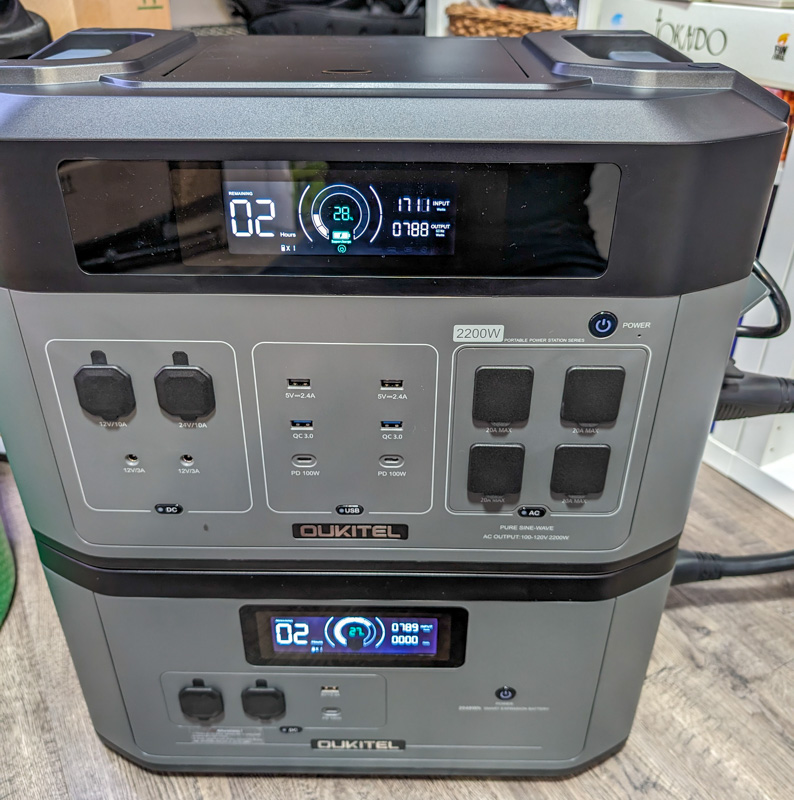
REVIEW – I’ve reviewed so many power stations so far that differentiating them can sometimes become difficult: there’s only so many variations in the 1000-2000 Wh power station category. However, the OUKITEL BP2000 Home Battery Backup caught my eye because it’s advertised as specifically a home backup battery solution, and not just another standard portable power station. I’ve been using power stations as emergency backup batteries for our garage fridge/freezers, but even larger 2000 Wh ones can run out in a day in the hot summer if the freezers have to run frequently. The OUKITEL BP2000 Home Battery Backup seems like it could be just the thing to run things for a bit longer in case of serious outages for us.
What is it?
The OUKITEL BP2000 Home Battery Backup is a power station that has home battery backup features such as UPS (uninterruptible power supply). The user can add up to 7 expansion B2000 batteries to the base BP2000 station, for up to 16 kWh of home energy storage. For comparison, the Tesla Powerwall 2 has 13.5 kWh of useable energy storage (though it has other things going for it like a higher continuous power input/output capability).
What’s in the box?
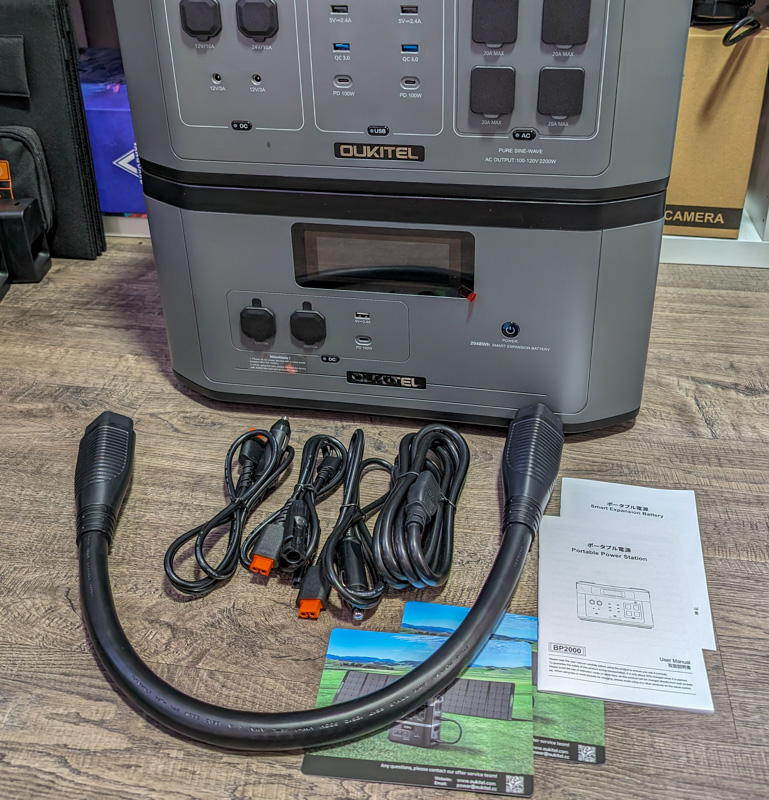
- OUKITEL BP2000 Home Battery Backup
- AC charging cable
- MC4 cable
- Car charging cable
- Battery extension
- Manual
Hardware specs (BP2000 main unit)
Click to view
- Power: 2048 Wh @ 51.2 V
- Capacity: 640,000 mAh
- Chemistry: LiFePO4
- Cycle life: 3500+ cycles to 80%
- AC charging: 12-120V/15A , maximum 1800W
- AC Charging time at maximum watts: 1.5 hours for base BP2000
- Solar panel connector: XT60 port, 12-120V/15A MPPT Max 1000W
- Solar charging at max watts: 2.5 hours for base BP2000
- Car charging: 12V/8A, 24V/10A
- Discharge while charging: yes
- Rated power: 2200W
- UPS rated power: 1400W
- Surge power: 4000 W
- Frequency: 60Hz/50Hz
- Overload: 2200W≤load<3000W constant power, 3000W≤load 4000W @5s; 4000W≤load @0.5s
- Inverter efficiency: η=92%
- Depth of Discharge: 90%
- AC ports: 5 ports, 2200W shared
- USB ports: USB-A 2 x 12W (5V/2.4A), USB-A 2 x 18W (5V/3A ; 9V/2A; 12V/1.5A), 2x USB-C PD100W (5V3A ;9V3A;12V3A;15V3A;20V5A )
- DC24V: DC24V 1* 24V10A socket DC12V 2* 12V3A socket
- DC 12V: 12V/10A socket
- Car lighter port: 12V/10A socket
- BMS: Rescue & Short-circuit, Over-current, Over-voltage, Low-voltage, Over-load, Over-temperature ,Over-charge
- Charging temp: 0-40 ℃ /32-104℉
- Discharging temp: -10-40 ℃ /-4-104℉
- Cooling: 6 fans
- Dimensions: 18.9″ x 11.7″ x 12.7″ | 480 mm x 296 mm x 322 mm (L/W/H)
- Certifications: CE,FCC,PSE,UN38.3,EMC,LVD,RoHS,MSDS
- Warranty: 3 years
Hardware specs (B2000 expansion battery)
Click to view
- Power: 2048 Wh @ 51.2 V
- Capacity: 640,000 mAh
- Chemistry: LiFePO4
- Cycle life: 3500+ cycles to 80%
- AC charging: 12-120V/15A , maximum 1800W
- AC Charging time at maximum watts: 1.5 hours for base BP2000
- Solar panel connector: XT60 port, 12-120V/15A MPPT Max 200W
- Car charging: 12V/8A, 24V/10A
- Discharge while charging: yes
- USB ports: USB-A 1 x 12W (5V/2.4A), 1x USB-C PD100W (5V3A ;9V3A;12V3A;15V3A;20V5A )
- DC48V: DC24V 1* 48V15A socket, DC12V 2* 12V3A socket
- Car lighter port: 12V/10A socket
- BMS: Rescue & Short-circuit, Over-current, Over-voltage, Low-voltage, Over-load, Over-temperature ,Over-charge
- Charging temp: 0-40 ℃ /32-104℉
- Discharging temp: -10-40 ℃ /-4-104℉
- Cooling: 6 fans
- Dimensions: 18.9″ x 11.7″ x 9.4″ | 480 mm x 296 mm x 239 mm (L/W/H)
- Certifications: CE,FCC,PSE,UN38.3,EMC,LVD,RoHS,MSDS
- Warranty: 3 years
Design and features
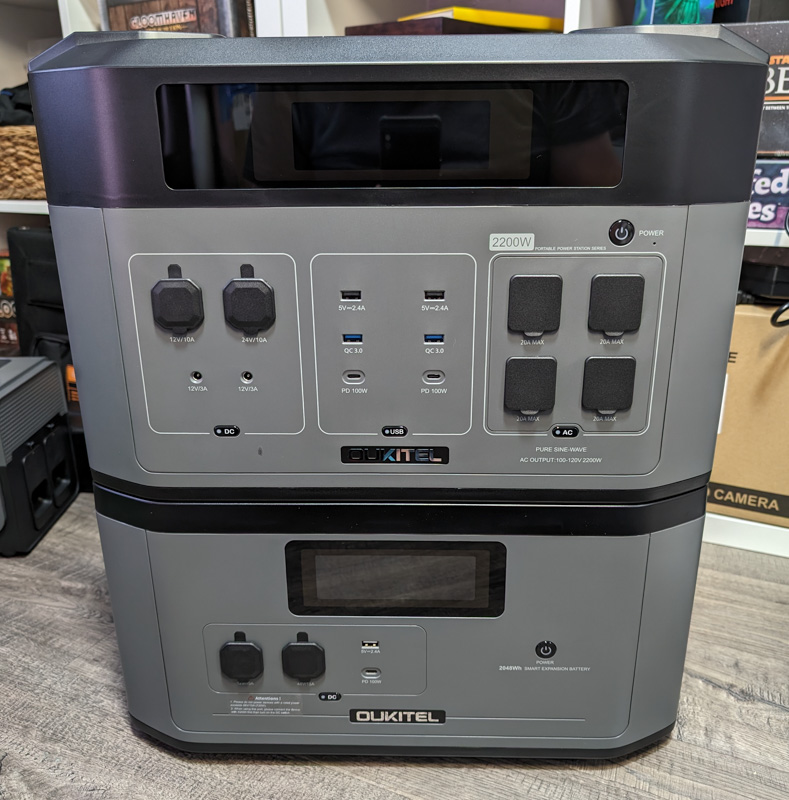
In most of my photos, the main power station is on top, with the B2000 expansion battery beneath. If you purchase just the BP2000 main unit, you’d be getting just the top portion, and if you purchase additional battery units, they’d slot under the first one below the BP2000 main unit.
The OUKITEL BP2000 Home Battery Backup follows the same form factor as most power stations: a rectangle with an LCD information panel on front, and sets of input/output ports on the front and sides. The exterior is a stiff and rugged plastic (they list ABS and PC as the external materials). There are three sets of outputs on the front of the main BP2000 unit, each of which can be toggled on or off with a button that has a light to indicate on/off status. On the left are the DC outputs (two car cigarette lighter style DC ports and two smaller pin DC ports). In the middle are six USB ports: two standard USB-A 5V/2.4A, two USB-A QuickCharge 3.0 ports, and two USB-C 100W Power Delivery (PD) ports. To the right are four AC ports (a fifth is hiding around to the left side – I’ll get to that later, but it also is turned on and off with this cluster of four). These front four are standard US (if you order in the US) 3-prong plugs, and can run a sustained load of up to 2200 watts of connected devices (peak 4000 watts). This means that higher wattage devices that won’t work with smaller power stations run fine here: when I run two freezers and a refrigerator, and even if all 3 start simultaneously, the peak wattage doesn’t overload the unit.
If you add one or more B2000 expansion batteries to the system, each one sports it’s own LCD info panel, and adds two car/cigarette lighter DC ports, a USB-C PD port, and a standard USB-A 5V/2.4A port.

The LCD panel tells me everything I’d want to know: current battery level, input/output wattages, and ETA to full/empty at the current load. There’s also useful info like if the UPS function is active, how many external B2000 batteries are connected, and more.
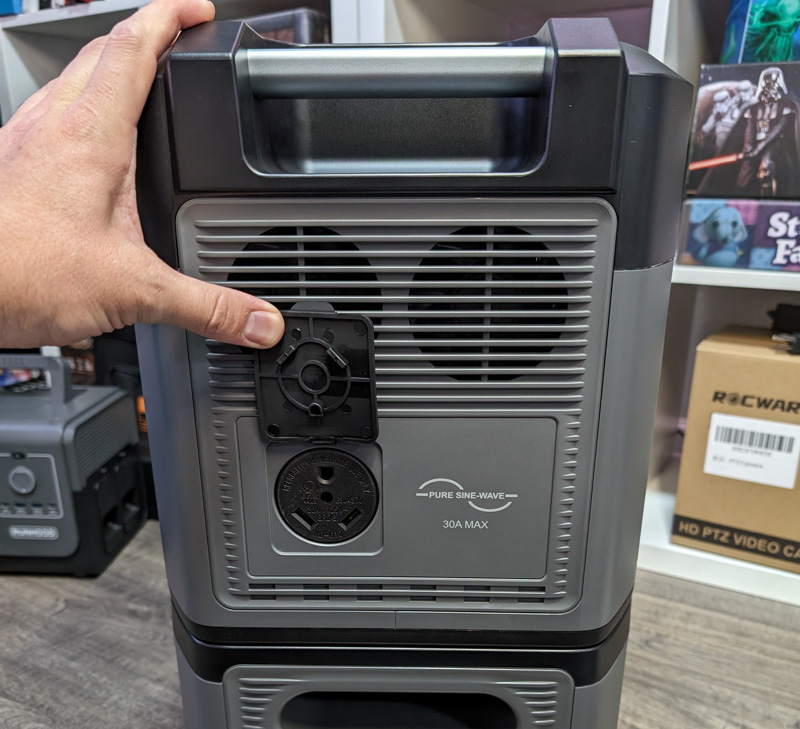
On the left side is the “RV” AC port. This is a 30 amp capable plug, but has a warning printed on it to only use it with recreational vehicles. I’d imagine this is a nice option to have if you’re going to be using this as your power source for an RV setup.
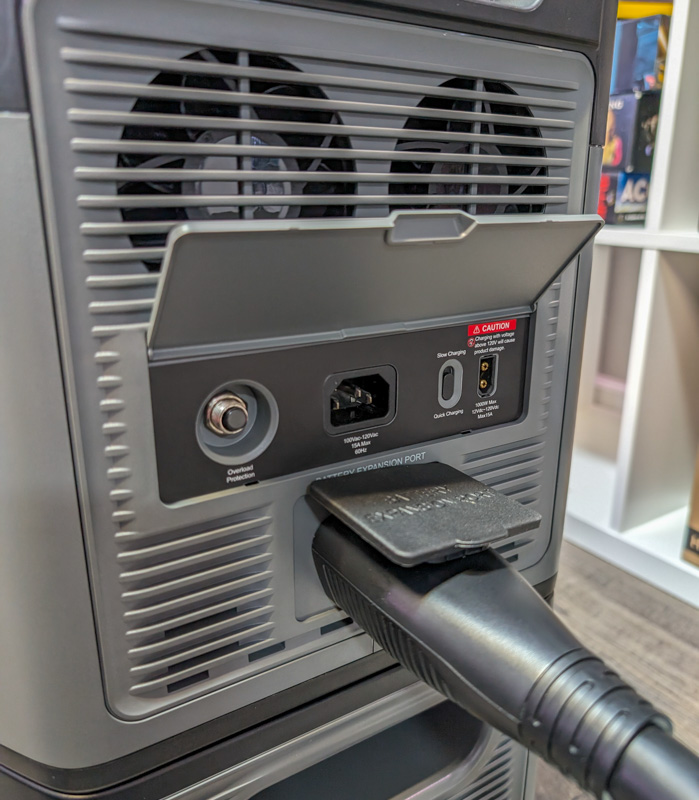
The right side of the OUKITEL BP2000 Home Battery Backup are the power inputs (AC up to 1800 watts, and DC/solar up to 1000 watts – which can both be used simultaneously if you really want to fill up the system fast). I really like that the AC input has a slow/quick charging toggle – the 1800 watts can be too much power on some people’s outlets (we have a few that are iffy at that level). Additionally, if you don’t need the fast AC charge option it’s better on battery cells to charge them slower. Finally, there’s a reset button in case you overload the system and need to reset. Below these input options is the “battery expansion port”.

The included cable reminds me of a Tesla car charging cable, both in shape and size. One end plugs into the BP2000 and the other into the B2000 expansion battery.
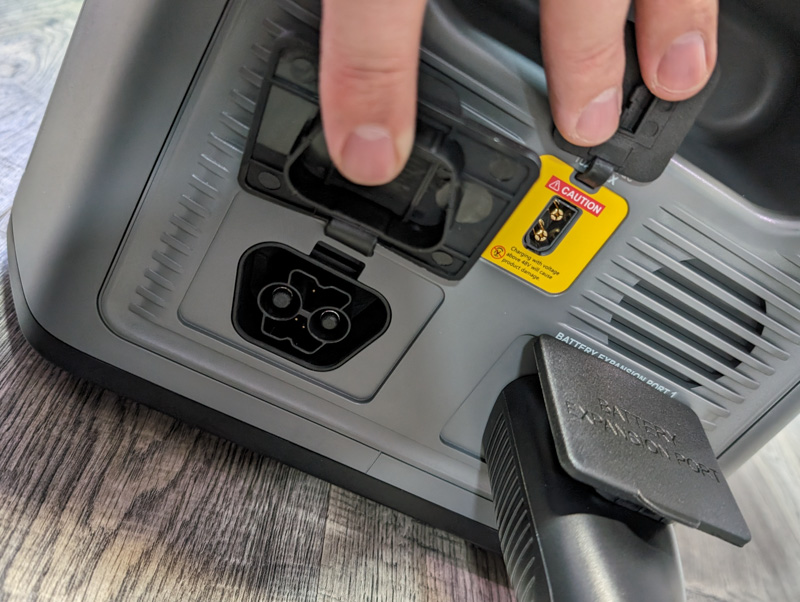
If you’re adding more than one B2000 expansion battery, you can keep daisy-chaining from one to the next, using the same battery expansion cable (one is included with each B2000 as well).
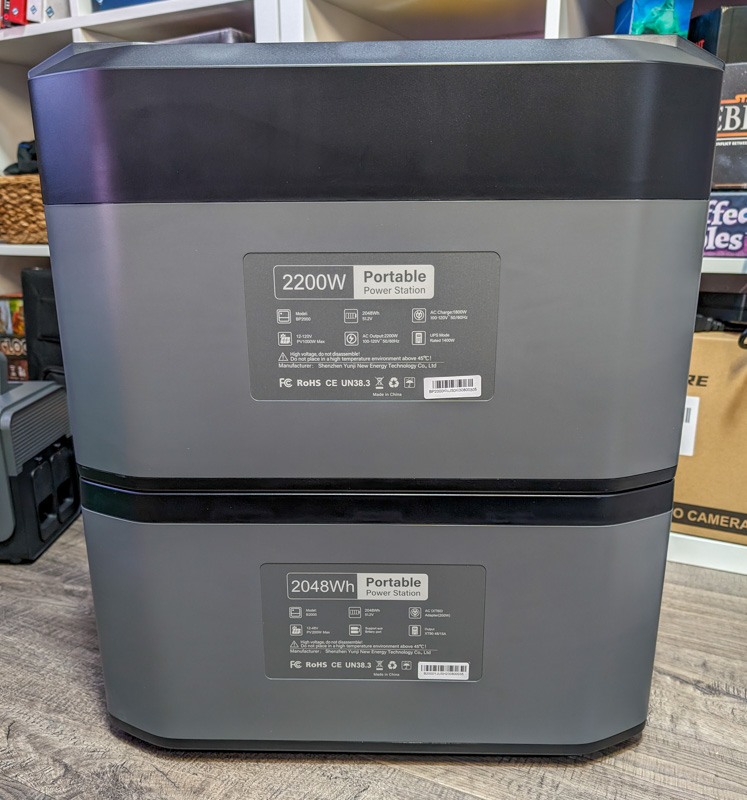
The back of both devices has serial barcodes and model information, as well as certifications and some basic info.
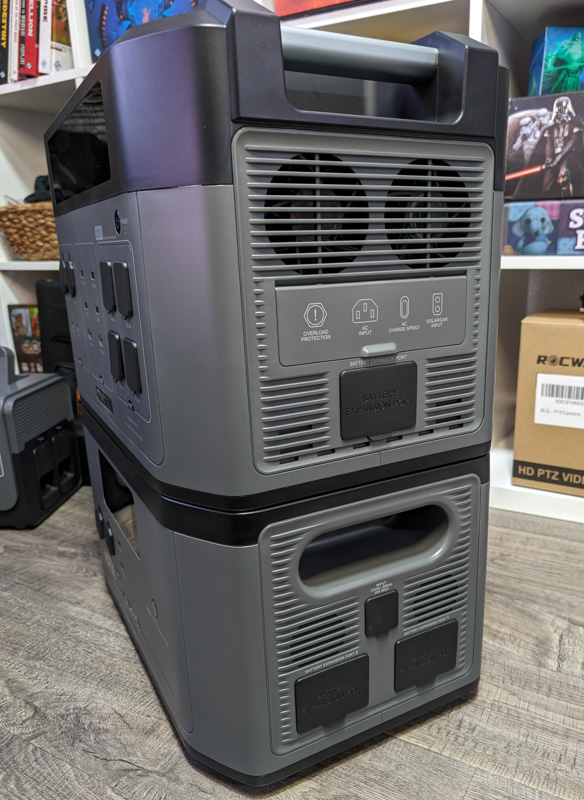
The above shot of the right side shows some of the fans (there are six in total on the BP2000 and ventilation as well as the side ports.)
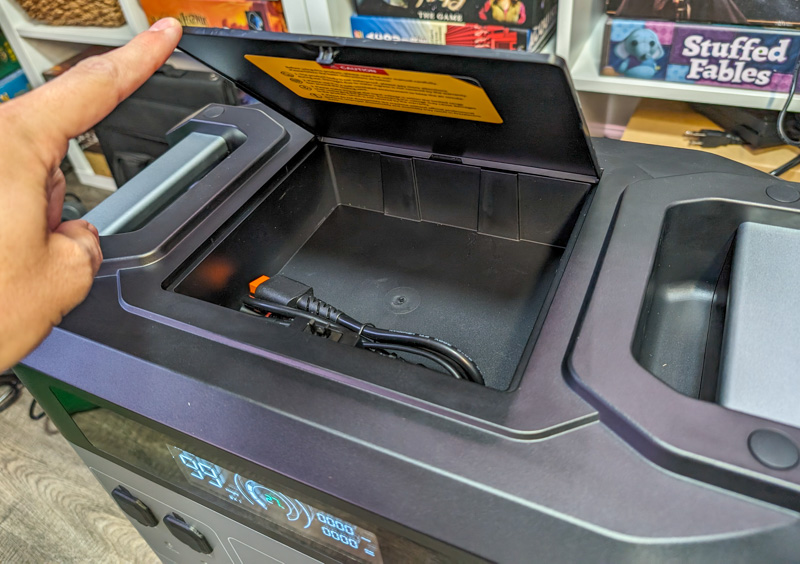
The top of the OUKITEL BP2000 Home Battery Backup has two sturdy carrying handles (the B2000 expansion batteries have grooves in the sides for carrying which also work well). It also has a feature I’ve come to appreciate more than wireless charging on top: a little compartment for cable storage.
Setup
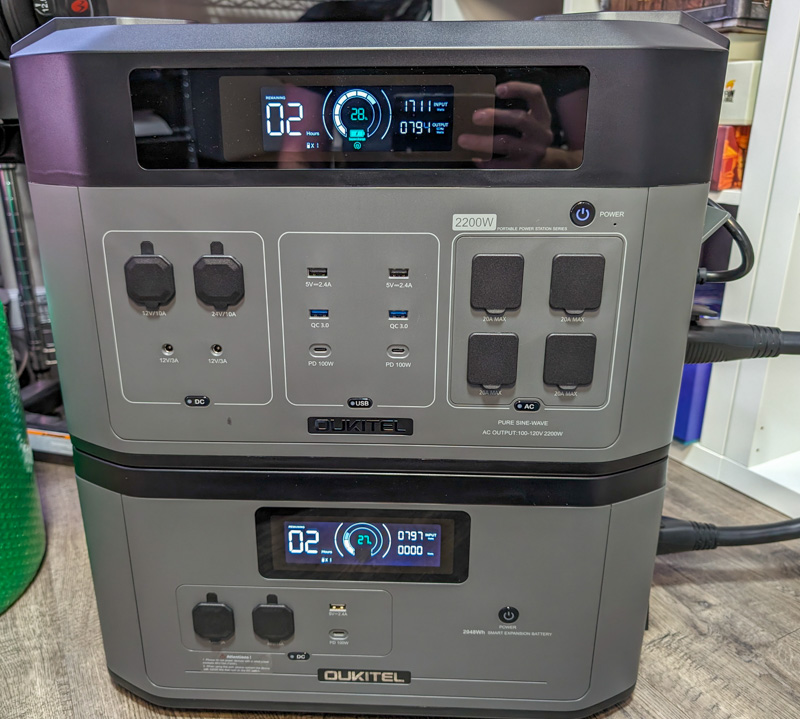
Setup involves charging the OUKITEL BP2000 Home Battery Backup via AC, car charger, or a solar panel or system (like the 400 watt one OUKITEL sells). The AC alone can charge up to 1800 watts, with up to 1000 additional watts of solar if you want. As you can see in the image above, those 1800 watts of solar are being distributed between the BP2000 and B2000 expansion battery, with an estimated 2 hours until both are full (from 28% starting).
Note from OUKITEL: AC max to 1800 watts to 80% just in 1.5 hours, solar charge up to 1000 watts, and AC 1500W + Solar 1000W dual charge to 80% in 1 hour.
If you leave the AC cable connected and enable the AC ports, a UPS mode indicator will display on the LCD screen, meaning power is being passed directly from the grid to your devices, while the battery is on standby until needed. If power goes out (or someone pulls the AC charging cable to simulated an outage), the OUKITEL BP2000 Home Battery Backup will switch to supplying electricity via battery within 10 milliseconds. This is a great feature if you’re using the system to backup anything sensitive like servers, NAS, computers, or routers.
Performance

I started testing the OUKITEL BP2000 Home Battery Backup with a stress test: a space heater that spikes to over 2000 watts when started, and then drops to about 1400 watts usage ongoing. The OUKITEL BP2000 Home Battery Backup worked great, no hiccups at all with the brief spike over 2000 watts (their spec sheet says it should be able to take up to 4000 watts of spike wattage without resetting.
I also tested a variety of other devices like 100 watt PD delivery to laptops, various AC chargers for devices that combined to over 1500 watts of combined power demand, and even an inflator using the DC car port (which has failed on some smaller power stations due to insufficient wattage). Everything worked like a charm as long as I stayed under the 2000 watt continuous draw limit, which is pretty good for most things (though the 1400 watt space heater was on track to drain the OUKITEL BP2000 Home Battery Backup in 71 minutes flat at that high rate of usage).
What I like
- Ability to add up to 7 extra expansion batteries to get up to 16 kWh of battery storage
- Nice variety of available ports
- LiFePO4 chemistry should mean a long life, and the 3 year warranty seems to indicate the company stands behind the build quality and components.
What I’d change
- Some competitors offer devices to integrate the home battery storage directly into the home’s grid (some with automatic failover to the battery backup, and others with the ability to use a manual switch). I would have liked to see that option.
- The high max kWh is nice, but output is limited to 2000 Watts no mattery how many expansion batteries you add. This 2000 Watt limit could be insufficient for some homes depending on what you’re trying to run on battery backup
Final thoughts
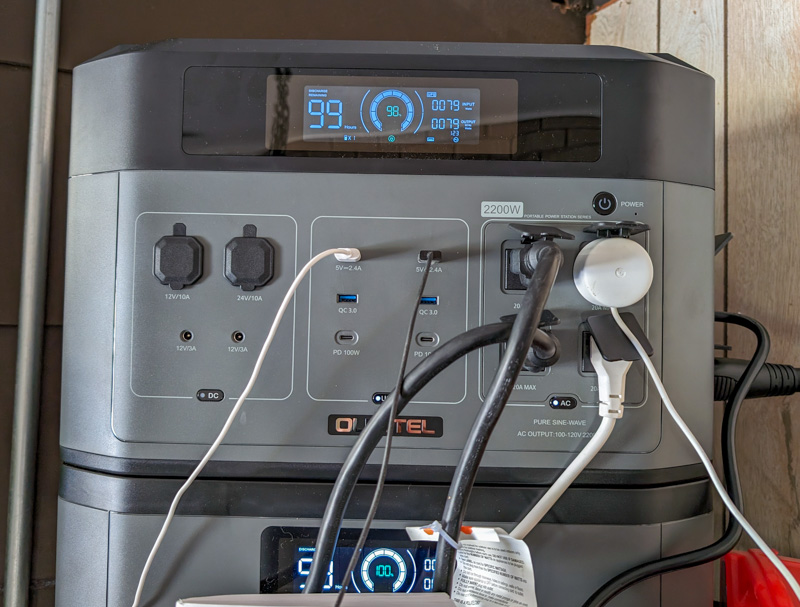
The OUKITEL BP2000 Home Battery Backup was an easy choice to hook up our freezers and refrigerator in our garage so we don’t lose hundreds of dollars of food in case of power outages (which we seem to always have a few of each year). The additional USB ports are nice for random devices that need to be charged in the garage, and I also have a few devices like tire inflators that use the car 12V “cigarette lighter” ports, so it’s nice just having those in the garage as well. I could see the OUKITEL BP2000 Home Battery Backup being a great solution for people that need more battery backup than all the other ~2000 Wh units on the market.
Price: The BP2000 is priced at $1699.00. If you purchase now, you’ll get a limited-time coupon. $2599.00 as reviewed with the BP2000 and 1x B2000 expansion battery.
Where to buy: Oukitel (save $600 on the BP2000 with code: B600 and save $600 on the BP2000 + B2000 bundle with code D600 expires 12/23/2023)
Source: The sample of this product was provided by Oukitel



Gadgeteer Comment Policy - Please read before commenting
So by my calculation a fully expanded system is around $9600? That’s a few thousand cheaper than a Tesla Powerwall. On the other hand, the latter is able to handle much larger solar inputs. If I read the article correctly, no matter how many batteries, one is always limited to 1800w of solar input. This seems to rule it out as an off-grid home power solution.
Who sells a modular home energy solution that can take sufficient solar/wind power input? I’m building an off-grid house and would love to see a list.
Does anyone know why in ups mode the ventilator is turning every couple of hours? If it would be in bypass mode nothing would get warm?
This is true of many different brands of batteries that I’ve reviewed here, all of them kick on the fans occasionally even when running in UPS mode. For whatever reason something in there is getting hot even though it’s just passing the power through.
The most important part of this presentation you made would have been the link with my home electrical network .
It is useless for me and for the other 9 billion people on this earth if i have to plug the devices in it . I want an ups for my home . How can i transform this into that ?
The 30A RV outlet is probably your best bet to connect this system to your home grid. I’d recommend checking with an electrician if you want to go that route, I’m still using this setup as my garage fridge/freezer backup (I have other power stations for indoor stuff in case of emergency).